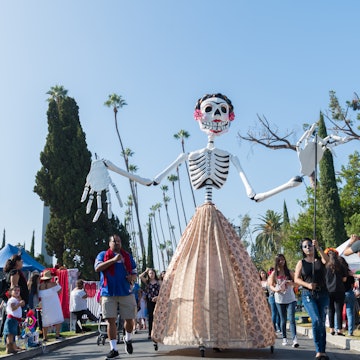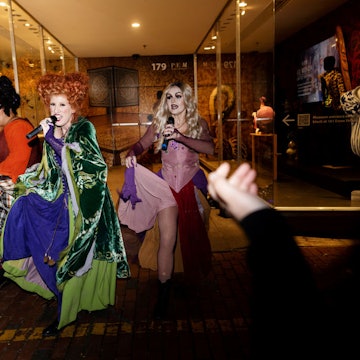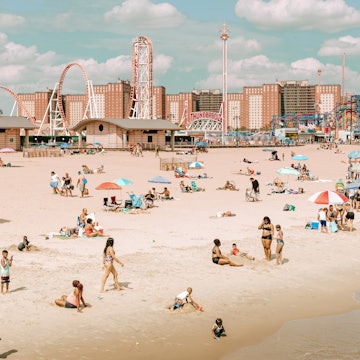

© [##INFO TBC]
When looking at a work of art, the setting counts. It’s a different, arguably more inspirational, experience seeing paintings in the studio where they were originally created. You might understand maritime artist Winslow Homer better by sharing the ocean view from his studio terrace, or better appreciate Jackson Pollock’s Abstract Expressionist technique by seeing the state of his paint-caked floors.
And you might understand your favorite artists better as people, too. Did realist painter Edward Hopper have enough chairs to invite friends over for a meal? What did minimalist Donald Judd like to collect? Here are eight illuminating artist house museums across the northeast, showcasing the lifestyles and artwork of painters, architects, photographers and sculptors.

Renee & Chaim Gross Foundation, New York
You could almost miss this house museum nestled in a nondescript four-story brick townhouse at 526 LaGuardia Place in Greenwich Village, the heart of a neighborhood dense with NYU students and trendy eateries. The ground-floor windows – once a storefront, but converted in 1963 into the dramatically skylit studio space of modernist sculptor Chaim Gross – are filled in with bricks. But on Thursdays and Fridays the wrought iron gates at the entryway to the Renee & Chaim Gross Foundation are unlocked to visitors.
The foundation’s guided tours highlight Gross’ wood and marble sculptures as he left them in the studio, and upstairs, his living areas where plush velvet furniture shares wall space with over 200 artworks from his personal collection.

Pollock-Krasner House and Study Center, New York
When Abstract Expressionist painters Jackson Pollock and Lee Krasner moved to East Hampton as newlyweds in 1945, their modest house had no indoor plumbing or central heating. After borrowing money for a down payment from Pollock’s dealer and patron, Peggy Guggenheim, they slowly renovated the home over the years – usually after successful gallery shows provided them with enough cash.
Krasner initially used the back parlor as her studio. Pollock painted in a barn on the property, where the paint-coated floor still has remnants of his monumental poured paintings. After Pollock’s death, Krasner took over the barn studio and traces of her gestural paintings color the walls. Opened to the public as the Pollock-Krasner House and Study Center in 1988, quirky treasures are on display. The studio has a human skull that Pollock lifted from the Art Students League, where he took classes in the 1930s. A broken anchor, found by the pair during a walk on the nearby beach, is mounted on the wall.

Andrew Wyeth Studio at Brandywine Museum of Art, Pennsylvania
While Andrew Wyeth’s peers were diving deeper into abstraction, he was painting realistic landscapes and portraits of neighbors. Many of his works were inspired by the immediate surroundings of his schoolhouse-turned-studio in rural Pennsylvania. Wyeth lived in Chadds Ford for two decades and painted there for almost 70 years, in a property that was walking distance from the studio and home of his father, illustrator NC Wyeth.
Today the Andrew Wyeth Studio, which belongs to the Brandywine Museum of Art along with the NC Wyeth House & Studio, contains objects dear to the beloved painter. There are around 900 miniature soldiers, books about his favorite artists, and, among his paintbrushes and pigments, a carton of eggs – a nod to the fact that Wyeth painted almost exclusively with egg tempera, an ancient artistic technique.

Donald Judd Foundation, New York
The home and studio of minimalist artist Donald Judd, now known as the Donald Judd Foundation, are not just a museum. They form a postmodern five-story installation piece, encased by a historic cast-iron building dating to 1870 in Manhattan’s SoHo neighborhood.
After Judd bought the entire building in 1968, he set up his live-work spaces as a complete artwork. Judd’s kitchen utensils, such as a Russian samovar and industrial meat-slicer, are meant to coexist with artwork by Marcel Duchamp, Jean Arp and Judd himself. Books are intentionally still on the studio floor. The pottery that Judd collected is no less valuable than artwork by Frank Stella. Guided tours are required to see the installation in its entirety, and all guides are practicing local artists themselves.
Winslow Homer Studio and House, Maine
It seems obvious that an artist like Winslow Homer, who is best known for his seascapes and paintings of men on boats, would live near the ocean. And he did, but only after a childhood spent around Boston and two decades of living in the hustle and bustle of New York City. At age 48, an unmarried Homer decided to move to a carriage house in Maine with panoramic views of the Atlantic. He ultimately spent the rest of his reclusive life there, close to 30 years.
Recently restored by the Portland Museum of Art, the Winslow Homer Studio and House is now open for guided tours. Visitors can see the artist’s personal furnishings, photos and artworks, and step out onto the studio’s second-floor balcony to glimpse the same ocean view that inspired Homer.

Edward Hopper House Museum & Study Center, New York
American realist painter Edward Hopper had just two addresses during his 84-year lifetime. The first was his lower Hudson Valley birthplace (where he lived until his 20s), and the last was a sparse fourth-floor walk-up at 3 Washington Square North in Manhattan’s Greenwich Village. Both locations are open to visitors (the Manhattan studio by appointment only), but the more elaborate display is at the Edward Hopper House Museum & Study Center in Nyack, where Hopper’s sketches, holiday cards and family memorabilia are on view. Hopper’s childhood bedroom has recently been restaged so that visitors can see the view of the Hudson River that the artist had from his window, and some early artistic materials.

Walter Gropius House, Massachusetts
The New Englanders invited over for dinner at the home of Walter and Ise Gropius must have been shocked by their first peek at metal and leather chairs, glass bricks and chrome banisters lining the spiral staircase. The modern design aesthetic that the couple imported from the Bauhaus – a progressive German art school founded by Gropius in the early 20th century – was initially a bit far out for Massachusetts natives accustomed to colonial brick and decorative woodwork. But as a professor at Harvard University’s graduate design department, Gropius’ influence soon turned his neighbors around.
The modest Gropius House is almost a miniature design museum and features a Marcel Breuer–designed double desk, as well as a plastic molded womb chair designed by Finnish architect Eero Saarinen.

Alice Austen House, New York
This traditional Victorian cottage on New York’s Staten Island is named after its most unconventional resident: Alice Austen. She was one of the earliest female American photographers, producing over 8000 photographs in her lifetime. She was also the first woman in her borough to own a car, and was involved in a romantic relationship with another woman, Gertrude Tate, for over 50 years.
An impoverished Austen lost ownership of the house in the 1940s. It soon fell into severe disrepair and was slated for demolition. But a group of activists rallied and raised funds to save the Alice Austen House, which is now listed on the National Register of Historic Places for both its architectural history and as an LGBTQ site of significance. As a museum, the house displays Austen’s photographs of a bygone New York and objects related to the daring woman who captured them.
Get more travel inspiration, tips and exclusive offers sent straight to your inbox with our weekly newsletter.
Make sure you're ready for anything with travel insurance from our trusted partners.
Explore the epicenter of American art with Lonely Planet's New York City guide.















